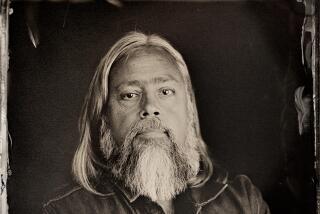Man in a Cage : OTA BENGA: The Pygmy in the Zoo, <i> By Phillips Verner Bradford and Harvey Blume St. Martin’s Press $22.95; 281 pp., illustrated</i>
- Share via
The title and jacket copy of this alluring book suggest one story of an African adrift in America. Instead, its uneven narrative and appendix of newspaper clippings weave together four competing stories.
First, the authors sketch in Americans’ post-Darwinian fascination around 1900 with their “primitive” brothers around the world. It revitalized the science called anthropology and produced a great deal of commercial hype at fairs and museums. Second, we follow the colorful life of Samuel Phillips Verner, Presbyterian missionary, African explorer, and special agent for the 1904 St. Louis World’s Fair to secure Pygmies. Third, a good-natured pygmy and alleged cannibal with pointed teeth, Ota Benga, agrees to go on exhibition for the summer in the Anthropology Section of the Fair. Two years later, he turns up in the monkey cage at the Bronx Zoo for three weeks. In both places he drew huge crowds. Fourth, the book depicts in Chapters 11 and 12 the episodic yet genuine friendship between Ota the Pygmy and Verner the lapsed missionary who learned Ota’s language. A sheaf of photographs make the stories graphic.
I find the fourth story the most remarkable. It describes an attachment based on sympathy, mutual dependence, and perhaps a little witchcraft. In the Congo kingdom of Ndomba, Verner’s “palavers of God” and his behavior earned him the title of Fwela or leader. After Ota had done his stint as a scientific specimen at the fair, he and Verner spent an exciting interlude together in New Orleans waiting for their ship. One of the post-Christmas parades of the local black Zulus found the pair wandering in the streets and, while Buddy Bolden blew his legendary horn, carried off the Bushman and the white man to join the night’s jazz-driven festivities in Johnson Park. At least that’s the tale told here; no sources are cited. The two spent the next eighteen months in Africa, where Ota turned the tables on Verner and exhibited the Fwela in a pen with rocking chair, pipe, books, and Edison phonograph. The natives were impressed. What held the two men together? Each was partially cut off from his own society. In their irregular circumstances each was drawn to the other’s exotic disposition for companionship. Ota returned to the United States with Verner, but the demands of economic survival soon separated them.
The publishers wish to favor Ota Benga’s story. All the evidence suggests that he was friendly, shrewd in sizing up a situation, and endowed with the gift of comic mimicry. On their reservation in St. Louis Ota and his six fellow Pygmies staged mock military drills in which, keeping perfect time to the music from a nearby military band, they marched off in all directions and enacted total chaos. Audiences were convulsed with laughter. Ota ended up in the monkey cage in the Bronx Zoo because it made great publicity for the zoo and he didn’t mind the arrangement until the crowds became too curious. During the newspaper coverage of one such episode the black clergyman Dr. MacArthur provided the most trenchant comment. “We send out missionaries to Africa to Christianize the people, and then we bring one here to brutalize him.”
The authors of this biography cannot cite first-hand written sources in order to reveal Ota’s thoughts and reactions. They fall back frequently on speculation and semi-fictional narrative to fill in the gaps. At these points the book leans dangerously toward stereotype and legend. Toward the end of his life Ota seemed to have found an acceptable way of life in Lynchburg, Virginia. Kept under the protection of the seminary, he taught African-style hunting to boys of the neighborhood. He even had his teeth capped. The boys called him Otto Bingo. But the Pygmy had not really put down roots. Verner, the only friend on this continent who could talk his language, was working far away as a medic on the Panama Canal. Ota had not reached thirty when he put a bullet through his heart.
Through these intertwined personal stories, the authors supply a fair amount of background, sometimes distracting, on cultural history and on African colonization and the atrocities of King Leopold’s police force of Zappo-Zap troops. The lengthy front matter confirms the impression one receives on reading through the book itself. After gossipy acknowledgments (they belong at the end), the preface deals in a highly personal way with the affection of one of the authors for his grandfather Verner and his resolve to set the record straight on that eccentric career. The introduction sternly corrects the preface and declares: “This, then, is the long-delayed story of Ota Benga.” I surmise that the first version of the book, by Bradford, was focused on his grandfather Verner. Blume was brought in to revise the story to justify the subtitle, “The Pygmy in the Zoo.” Irregularities in style and a certain jaggedness in the narrative further the impression. Nothing here surpasses the vivid and moving situations presented in Ashley Montagu’s “The Elephant Man.” But Ota Benga’s is a story worth telling, more substantial than a freak show, a case in which sheer humanity plays a more important role than race or color.
More to Read
Sign up for our Book Club newsletter
Get the latest news, events and more from the Los Angeles Times Book Club, and help us get L.A. reading and talking.
You may occasionally receive promotional content from the Los Angeles Times.









